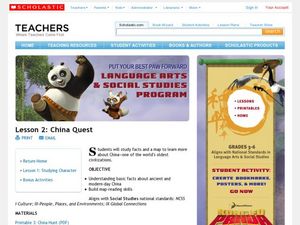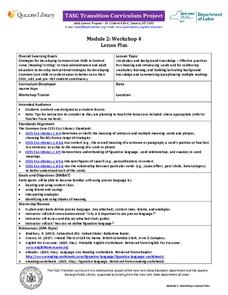EngageNY
End of Unit 2 Assessment: Working with Two Texts - Reading, Listening, Summarizing, and Synthesizing
As a summative assessment for this unit on colonial trade, fourth graders listen to and read informational texts in order to demonstrate their ability to take notes, write summaries, and draw connections. Young scholars first listen as...
US Institute of Peace
Defining Conflict
Before there can be peace, we have to understand conflict. Introduce the concept of conflict through a two-part activity that combines discussion, collaboration, and writing. The first in a 15-part series examines the multiple meanings...
EngageNY
Summarizing Complex Ideas: Comparing the Original UDHR and the "Plain Language" Version
The eighth lesson plan in this series continues the focus on vocabulary and increasing young readers' awareness of academic language. Pairs of learners participate in a short vocabulary review activity called Interactive Words in which...
Curated OER
In Search of Ethnic Identity in Selected Narratives: New Reading, New Meaning
Young scholars read texts reflecting multiple cultural perspectives.
Curated OER
Cinco De Mayo: ELD Reading and Language-Building
A brief passage about the Mexican holiday Cinco de Mayo is accompanied by an array of language activities for ELD: cloze exercise, phrase matching, word jumble, multiple choice, sequencing, interview, group presentation, fluency writing,...
Curated OER
International Dance Day: Reading and Activities for ELD
A brief passage about International Dance Day, April 29, is accompanied by an array of language activities based in sound ELD practice: cloze exercise, phrase matching, word jumble, multiple choice, sequencing, interview, group...
Curated OER
China Quest
Read and research information on China. Young researchers complete a knowledge hunt about China then locate and describe each location using directional words. They recognize the word meaning through context clues and application practice.
Curated OER
Worth a Thousand Words: Depression-Era Photographs
High schoolers view images of New Deal programs to see its successes. They work in groups to create captions for the images and suggest captions that might indicate different meanings.
New York State Education Department
TASC Transition Curriculum: Workshop 4
Why is it important to use precise language? Participants explore this question in the fourth activity in a series of 15 on effective instruction. Perfect for all content areas, the activity promotes appropriate language choice through...
Bully Free Systems
Bully Free Lesson Plans—Eighth Grade
Middle schoolers are likely very familiar with the concept of bullying and cliques. Discuss their experiences and brainstorm ways to handle peer conflict and feelings of exclusion with a poem that focuses on bullying, and a second lesson...
Council for Economic Education
Understanding a Balance Sheet
Read any financial website or book, and it is bound to discuss the words asset and liability. But what do these words actually mean to the class? The resource effectively explains by using multiple formats and techniques, including...
TED-Ed
A Brief History of Religion in Art
Did you know that some languages have no word for art? The English language does and the narrator of this short video discusses the aesthetic dimension of religious art as it "visually communicates meaning beyond language."
Curated OER
Crossing the Delaware with Historic, Cultural, and Personal Interpretations
Sixth graders discover the importance of information sources by researching the United States History. In this research gathering instructional activity, 6th graders examine a historical painting of George Washington and analyze...
Curated OER
Sneetches: Diversity of Learners
For Learners wanting to practice verbal/linguistic intelligence, any Dr. Seuss book is an excellent text for examining rhyming words. They explore words that rhyme with bully, mean, snooty, nasty, tease, harass, hurt.
Curated OER
World Hepatitis Day
In this World Hepatitis Day learning exercise, students complete activities including reading a passage, matching phrases, fill in the blanks, correct word choosing, multiple choice, sequencing, unscramble the sentences, write questions,...
Curated OER
More Than Words: Racism, Identity And the Power of Words
Students explore how words can be powerful instruments of racism, and discuss ways to combat racism, prejudice and discrimination in their own lives.
Curated OER
Vocabulary Review: Government Terms
As your English language pupils learn about the government and vocabulary words commonly used when talking about the government, present them with this worksheet. There are eight multiple choice questions, and each vocabulary word is...
Curated OER
The Color of Success
Students participate in an activity in which they share with each other what success means to them. They are given bags of crayons and blank sheets of paper and create an image that displays what success means to them. Bags of crayons...
TED-Ed
How Languages Evolve
Do all languages have a common ancestor? Although no one yet knows the answer to that big question, the narrator of this short, animated video explains how linguists use migration patterns, geological features, and word clues to...
Civil War Trust
Contrasting the North and South before the War
Learners create a standing cube with four panels that display information on the North and South's economy, geography and climate, society, and means of transportation before the Civil War. Through discussion and reading...
While They Watched
Teaching the Holocaust
What is the difference between prejudice and discrimination? Between collaborators and bystanders? Guilt and responsibility? Prompt learners to think critically about a very complex and textured topic with an innovative packet...
Ohio State University
Lesson Plan on China
Scholars ponder the beliefs of Confucianism. After reading several sayings made by Confucius, participants complete a chart filling in what each saying means using their own words. Using the same quotes split in half, pairs match...
Curated OER
How Do You Learn Best?
In this learning styles worksheet, students, with a partner, take a quiz on how they learn best and discuss what intelligences and multiple intelligences mean.
National Endowment for the Humanities
The Victor's Virtue: A Cultural History of Sport
Pupils explore the meaning of the ancient Greek word aretê and the place of virtue in historical athletic competition and modern sports. They begin by reading an informational text on the goal of sports in education, and then...























